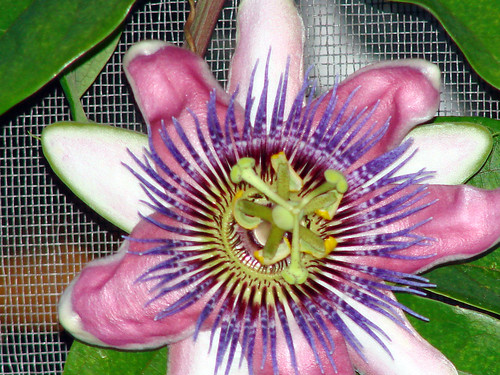
Join
A passion flower to remind us of the hottest days of summer.
This passion flower is Passiflora x belotii, it’s growing in a pot outside in my garden. It’s grown so much that it’s now climbing onto my enclosed back porches screened windows.
Passiflora x belotii is a hybrid of P. alata x P. caerulea. Named P. alato-caerulea by Dr Lindley in 1824, John Vanderplank’s book lists the following alternative names, P. x belotii, P. ‘Empress Eugenie’, P. ‘Imperatrice Eugenie’, P. ‘Kaiserin Eugenia’, P. munroi & P. x pfortii, some of which are still in use. The latest Passiflora Hybrid Lists have collapsed them all into ‘P. x belotii’.
Flower variations however include either a dark or light centre, one or a number of white bands on the coronal filaments & petals crumpled to varying degrees. Clearly there are a number of similar but distinct hybrids, probably all of P. alata x P. caerulea parentage.
Passion flowers are plants that grow as vines. This particular type can grow 20 to 30 feet. Mine is currently in the 20 foot range. They are hardy from USDA zones 7a to 10b. They thrive in sun to partial shade (bright shade, not dark shade).
Parts of the plant are dangerous if ingested, in fact the leaves give off a form of cyanide when crushed.
The blooms are pink to violet/ Lavender and the foliage has a shiny glossy texture. The blooms can be mildly fragrant. My blooms have a slight sweet candy like scent. Water regularly, this plant likes its soil moist but not damp. A well draining soil is needed for this plant.
This plant can be propagated from From softwood cuttings, semi-hardwood cuttings, simple layering, and by air layering. Seeds can be collected from ripened fruit and the plant can then be grown from seed.
I need to bring this plant indoors in the winter time as it is not hardy to my climate. I keep it in a brightly lit room and water it regularly to keep the soil slightly moist. It can be susceptible to spider mites and white fly so if you must also bring your passion flower indoors please try to keep the humidity up inside the house or the room in which the plant is housed. Occasionally misting the leaves and stems will help as well. It’s not uncommon for some of the leaves to drop off when brought indoors in the early fall. The plant will acclimate itself to your homes environment in a short while and will start to look healthy again if you care for it properly.
Gardeners, Plant and Nature lovers can join in every Sunday, visit As the Garden Grows for more information.
